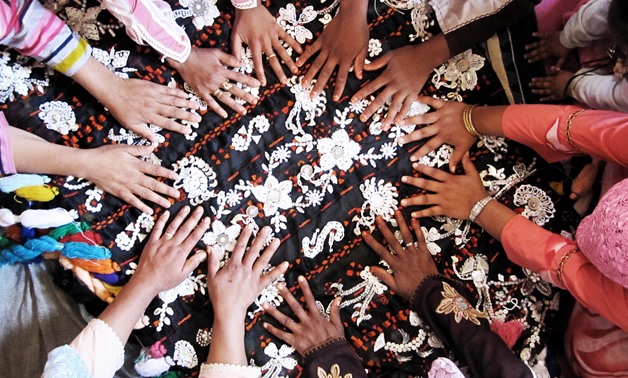
Photography courtesy of ByHAA
Byhand African Artisans (ByHAA) is on a mission to introduce sustainability to not only the market, but also to local artisans in North and East Africa as a long-term operations method. “When their abilities and the different materials are merged, it introduces a new level of artisanship with endless opportunities,” ByHAA say on their website, describing their aim as striving to maintain the culture and the heritage of the materials, the artisans and the designers who create their products.
ByHAA work hard in order to preserve their artisan’s rights financially, while building anunbreakable relationships with them. Last month Henrik Georg, Director and Co-founder of the organization, was in Aswan attending the wedding of one of ByHAA’s artisans, paying his respects to the team.
 Photography courtesy of ByHAA
Photography courtesy of ByHAA
In order to harvest the stone, the wood the wool and the cotton, they always aim to do it in a way that wont “plunder the Earth that we inhabit. We naturally come to represent globalization in areas where we work,” Georg explains of the organization which is run by a small team who aren’t driven by creating large profit, but by their shared mission to create a sustainable brand. They are currently working with a team of 25 artisans from all nationalities and all religions in the North and East of Africa.
Georg and his wife Ellen Simonia are originally from Denmark, who after first visiting Egypt back in 2004 immediately fell in love with the country. Upon returning to their home country after four months and the birth of their first child, they decided to move to Sinai to live and travel throughout Egypt, where they got to meet and become a part of the local craftsmen community. Some might say that they have seen more of Egypt than the average Egyptian.
 Photography courtesy of ByHAA
Photography courtesy of ByHAA
In 2009 they created their first samples for ByHAA, with artisans from Siwa and Kerdasa. They would go on to travel to find artisans. “The beauty of Egypt is that we [get to] travel a lot. We’ve seen a lot. We’ve been on a search, we’re still searching, we’re still constantly trying to find the good options for making sustainable products. That’s also what it is. It’s not just finding the artisans who can make a sandal. [If you want] to sell something you have to make it sustainable in a way where they also benefit in the long run. That’s the difficulty, to be able to develop new things with them,” Georg explains.
ByHAA products range from bathroom accessories, bedding, candlesticks, furniture, lighting, rugs and tableware to towels and pillows. When it comes to sourcing materials, Georg explains, “We never source any material, it’s the artisans [with] their contacts—it’s their business. That’s part of a system we don’t see much of. [But] everything is made here in Egypt. For example our kilims are made of cotton and wool 100 percent Egyptian.”
If you’re wondering about the price tag, ByHAA honors the artisans by letting them set the price themselves. “The artists create the price and if it doesn’t work in the market we [negotiate] a more suitable price. Sometimes compromise needs to happen in order to sell and be sufficient. . . . Prices depend on the design specifically, it’s more art. We are [also] trying to avoid all of the traditional designs [you see everywhere] by moving around to different places,” Georg says.
 Photography courtesy of ByHAA
Photography courtesy of ByHAA
ByHAA works with many materials such as limestone, salt, brass, alabaster, palm leafs, wool, cotton, wood, granite and marble, among others, while also using recycled brass, which can be seen in many of their products. Among the materials that they have had difficulty working with is glass. “It’s difficult to work with glass in Egypt, it’s difficult to make it sustainable, because of the competition worldwide. With stone, Egypt still has an advantage. It’s all sourced here in Minya and other places,” the founder explains.
The craftsmen and women have modernized simple home items by making small design changes. For example they inserted a split space in the middle of sphere brass lighting items, all of which are, naturally, handmade. “This is the way we work with the artisans, we work together and enrich one and another, says Georg, “Creating a different culture layer, where we benefit from each other.”
 Photography courtesy of ByHAA
Photography courtesy of ByHAA
ByHAA is slowly creating a network of artisans and craftsmen from across Africa by connecting them to each other, to work together. They are all from different locations for example Swia and Sinai. This also “creates other businesses [for them] on the side,” Georg adds, highlighting that most of their products are made by order so that extra stock does not go to waste. “We work through dialogue and the constant play between design and artisanship. Each design is brought to life through endless hours of play, hard work, sometimes frustration and in the end satisfaction when design and craftsmanship meet in perfection and harmony.”
You can find ByHAA at www.byhandafricanartisans.com/ Instagram: @byhand_african_artisans/ Facebook: @Byhand African Artisans
 Photography courtesy of ByHAA
Photography courtesy of ByHAA



Comments
Leave a Comment